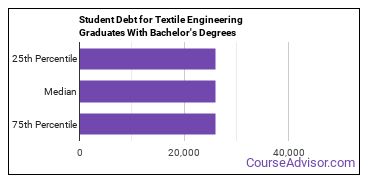Bachelor’s Degrees in Textile Engineering
Featured schools near , edit
Education Levels of Textile Engineering Majors
In 2020-2021, 214 bachelor's degrees were awarded to textile engineering majors. This earns it the #249 spot on the list of the most popular bachelor's degree programs in the nation.
The following table shows the number of diplomas awarded in textile engineering at each degree level.
| Education Level | Number of Grads |
|---|---|
| Bachelor’s Degree | 214 |
| Master’s Degree | 64 |
| Doctor’s Degree | 28 |
| Graduate Certificate | 4 |
Earnings of Textile Engineering Majors With Bachelor’s Degrees
The median salary for graduates holding a bachelor's degree in textile engineering is $45,374. A lot of factors can contribute to this number, such as the location of your workplace and the availability of other perks and bonuses. To get a better picture, earnings for this category of people can range from a low of $45,374 to a high of $45,374.

Student Debt
The median student debt for graduates holding a bachelor's degree in textile engineering is $26,000. The school you go to and how long it takes you to graduate, among other things, can cause this number to vary. The chart below shows the range of accumulated debt loads. On the high side of the range, $26,000 is the debt load, and the debt load on the low side is $26,000.

Those students who are paying back their debt on a 10-year repayment plan have a median monthly payment of $290.
Student Diversity
More women than men pursue their bachelor's degree in textile engineering. About 79.9% of graduates with this degree are female.
| Gender | Number of Grads |
|---|---|
| Men | 43 |
| Women | 171 |

The racial-ethnic distribution of textile engineering bachelor’s degree students is as follows:
| Race/Ethnicity | Number of Grads |
|---|---|
| Asian | 19 |
| Black or African American | 15 |
| Hispanic or Latino | 14 |
| White | 140 |
| International Students | 6 |
| Other Races/Ethnicities | 20 |

Most Popular Textile Engineering Programs for Bachelor’s Degrees
There are 3 colleges that offer a bachelor’s degree in textile engineering. Learn more about the most popular 3 below:
The most popular school in the United States for textile engineering students seekinga bachelor's degree is North Carolina State University. Roughly 36,000 attend the school each year. The average in-state tuition for full-time undergraduates is $6,535 per year, while in-state graduate students, on average, pay $9,095 per year. During the 2020-2021 academic year, 211 people received their bachelor's degree in textile engineering from NC State. Of these students, 80% were women and 28% were members of underrepresented racial-ethnic groups.
Thomas Jefferson University comes in at #2 on our list of the most popular colleges offering bachelor's degrees in textile engineering. Roughly 8,200 attend the school each year. The average in-state tuition for full-time undergraduates is $41,900 per year, while in-state graduate students, on average, pay $22,068 per year. During the 2020-2021 academic year, 3 people received their bachelor's degree in textile engineering from Thomas Jefferson University.
Explore Major by State
Alabama
Arkansas
Connecticut
Florida
Idaho
Iowa
Louisiana
Massachusetts
Mississippi
Nebraska
New Jersey
North Carolina
Oklahoma
Rhode Island
Tennessee
Vermont
West Virginia
Related Majors
Below are some popular majors that are similar to textile engineering that offer bachelor’s degrees.
| Major | Annual Degrees Awarded |
|---|---|
| Mechanical Engineering | 36,809 |
| Electrical Engineering | 17,320 |
| Civil Engineering | 15,193 |
| Computer Engineering | 12,194 |
| Chemical Engineering | 10,172 |
References
*The racial-ethnic minority student count is calculated by taking the total number of students and subtracting white students, international students, and students whose race/ethnicity was unknown. This number is then divided by the total number of students at the school to obtain the percentage of racial-ethnic minorities.
- College Factual
- National Center for Education Statistics
- O*NET Online
- Bureau of Labor Statistics
- Image Credit: By Unhindered by Talent under License
More about our data sources and methodologies.
Featured Schools
 Request Info
Request Info
|
Southern New Hampshire University You have goals. Southern New Hampshire University can help you get there. Whether you need a bachelor's degree to get into a career or want a master's degree to move up in your current career, SNHU has an online program for you. Find your degree from over 200 online programs. Learn More > |



